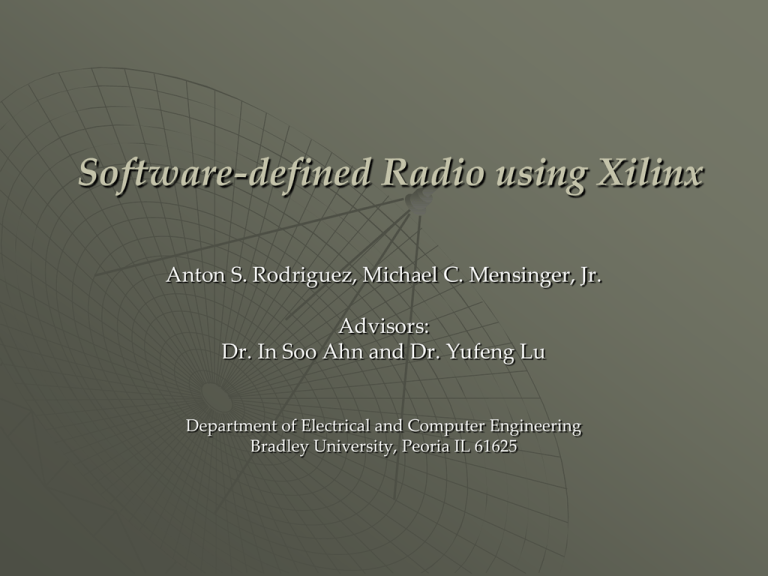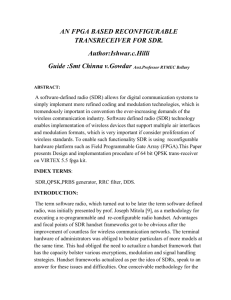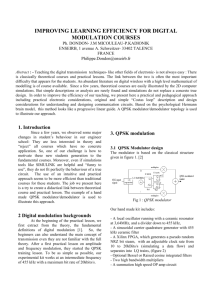SoRaX - Electrical and Computer Engineering Department
advertisement

Software-defined Radio using Xilinx Anton S. Rodriguez, Michael C. Mensinger, Jr. Advisors: Dr. In Soo Ahn and Dr. Yufeng Lu Department of Electrical and Computer Engineering Bradley University, Peoria IL 61625 Outline Motivation Project Goals Equipment QPSK Theory Background System Block Diagram Requirements Results Conclusions References Motivation A Software-defined Radio (SDR) provides a versatile wireless communication solution for a wide range of applications. Applications: • Cell phones • Military radios • GPS • Wi-Fi The SDR can be easily modified to the operating needs of individual applications. Lower costs • No expensive equipment • No need to replace hardware Project Overview The objective of this project is to design a communication radio system on an FPGA board. QPSK modulation scheme is used. The main focus is on the carrier synchronization and phase ambiguity correction from the received data. A Simulink model of the entire system is designed and then implemented on the SignalWave Virtex-II FPGA board . Project Goals Gain an in-depth understanding about the FPGA implementation of carrier synchronization. Achieve fast acquisition of carrier synchronization. Construct a working Simulink model. Implement the Simulink model on an FPGA board. Correct the phase ambiguity present in the recovered data. Equipment Virtex 4 FPGA Xilinx - ISE 9.2 Compiler SignalWave Virtex-II FPGA QPSK Signal Representation 2 bits s(t) = I(t)*cos(2πfot) – Q(t)*sin(2 πfot) = A*cos(2πfot + θ(t)) θ(t) I(t) Q(t) π/4 1 1 3π/4 -1 1 5π/4 -1 -1 7π/4 1 -1 Q I Background Previous QPSK Project Digital Data (Transmitter) Wired Channel Digital Data (Receiver) Objectives: • Make this system wireless • Overcome the following communication problems: Multi-path effect Carrier synchronization Phase ambiguity Multi-path Effect Random process. α1*x(t-τ1) A number of different paths may be traveled. A Constructive/destructive interference. α2*x(t-τ2) α3*x(t-τ3) B Carrier Synchronization Wireless communication introduces distortion due to channel imperfections. The carrier signals must be synchronized to decode data correctly for both I & Q channels. Phase Ambiguity Typical problem in QPSK systems. Due to the nature of phaselocking characteristics, a static phase error is introduced. Q Q I I Transmitted and decoded in-phase data Outline Motivation Project Goals Equipment QPSK Theory Background System Block Diagram Requirements Results Conclusions References System Block Diagram (Simulink Model) Channel Baseband Signal Shaping Raised-cosine filtering Reduces inter-symbol interference (ISI) Interpolator/Decimator Interpolator Decimator System Block Diagram (Simulink Model) Channel Phase-Locked Loop (Carrier Recovery) Corrected Signal X(n) I(n) FIR LPF r(n) cos(Өon+Ф) + - FIR LPF Y(n) -sin(Өon+Ф) Q(n) DDS Loop Filter Y(n)*I(n) - X(n)*Q(n) Functional Requirements System clock = 50 MHz Carrier signal frequency = 12.5 MHz • Data rate = 12.5 Mbps The frequency offset tolerance is 1 kHz. Results (Carrier Synchronization) QPSK signal I & Q waveforms Results (Phase Ambiguity) Transmitted Image Received Image Results (Phase Ambiguity Correction) Differential coding Channel Results (No Phase Ambiguity / Color) Transmitted Image Received Image Results (Preserved data / Color) Conclusions QPSK wireless communication system is designed • • • • • Simulink model is constructed Carrier synchronization is achieved using digital PLL Phase ambiguity is resolved using differential coding Tested whole system with real data Hardware implementation Demonstrated the configurability of a software-defined radio • Expandable to MPSK, MQAM and other modulation schemes Future Work Symbol timing Error correcting capabilities Implement other modulation schemes • 8PSK • 16PSK • and so on… Acknowledgements Dr. Yufeng Lu Dr. In Soo Ahn Senior Project Support from • Department of Electrical and Computer Engineering Bradley University, Peoria IL 61625 Questions? References Chris Dick, Fred Harris, and Michael Rice, FPGA Implementation of Carrier Synchronization for QAM Receivers, Journal of VLSI Signal Processing, Copyright © 2004 Kluwer Academic Publishers, Netherlands. Stephens, Donald R. Phase-locked loops for wireless communications digital and analog implementation. Boston: Kluwer Academic, 1998. Vinod Kumar Venkat Reddy Gari, “FPGA-based QPSK transceiver design”, Technical Report, Department of Electrical and Computer Engineering, Bradley University, November 2008. Altera Corporation, "PLL & Clocking Glossary," Altera, 1995-2010. [Online]. Available: http://www.altera.com. [Accessed: May 1, 2010].











